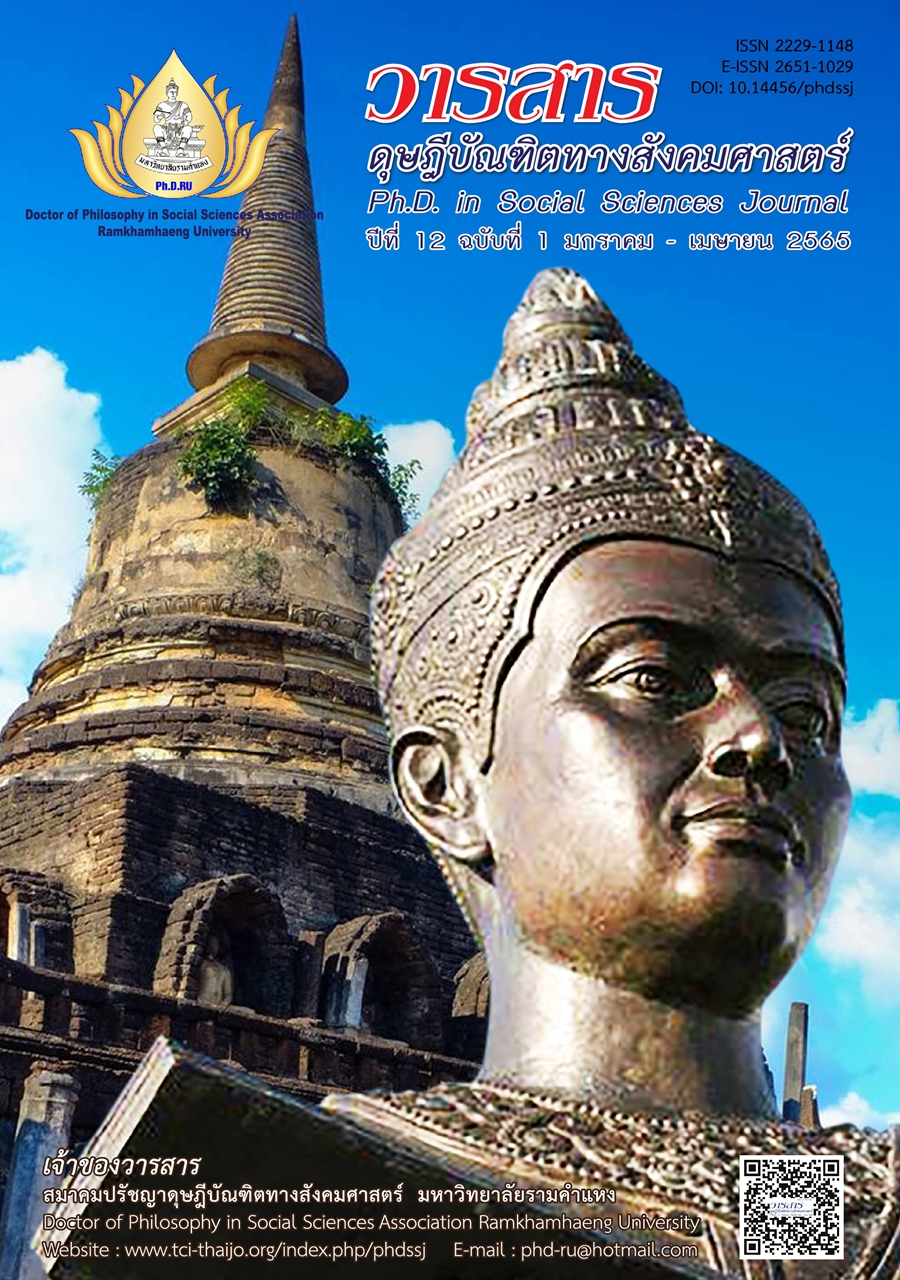ปัจจัยที่ส่งผลต่อพฤติกรรมการใช้เทคโนโลยีของผู้โดยสารในการตรวจคนเข้าเมือง ผ่านระบบตรวจหนังสือเดินทางอัตโนมัติในประเทศไทย
Main Article Content
บทคัดย่อ
บทความวิจัยนี้ มีวัตถุประสงค์เพื่อ (1) ศึกษาปัจจัยที่มีอิทธิพลต่อพฤติกรรมการใช้งานเทคโนโลยีระบบตรวจหนังสือเดินทางอัตโนมัติของผู้โดยสารสัญชาติไทยที่ใช้บริการตรวจคนเข้าเมือง และ (2) นำเสนอแนวทางในการส่งเสริมให้ผู้โดยสารใช้บริการระบบตรวจหนังสือเดินทางอัตโนมัติมากขึ้น ผู้วิจัยใช้ระเบียบวิธีเชิงปริมาณ ตัวอย่างรวมทั้งสิ้น 450 คน การวิเคราะห์ข้อมูลประกอบด้วย การแจกแจงค่าความถี่ ร้อยละ ค่าเฉลี่ย ส่วนเบี่ยงเบนมาตรฐาน และการวิเคราะห์โมเดลอิทธิพลเชิงสาเหตุ
ผลจากการวิจัย พบว่า โมเดลมีความสอดคล้องกับข้อมูลเชิงประจักษ์ โดยมีค่าดัชนีความกลมกลืนของโมเดล ดังนี้ χ2 = 137.09, df = 113, χ2/df = 1.21, p-value = 0.06, GFI = 0.98, AGFI = 0.95, CFI = 1.00, NFI = 1.00, TLI = 1.00, SRMR = 0.02, RMSEA = 0.02 และ CN = 562.85 และผลการทดสอบสมมุติฐาน พบว่า ปัจจัยความตั้งใจใช้เทคโนโลยีมีอิทธิพลทางบวกต่อพฤติกรรมการใช้เทคโนโลยีระบบตรวจหนังสือเดินทางอัตโนมัติ ที่ค่าสัมประสิทธิ์ เท่ากับ 0.92 ปัจจัยทางสังคมมีอิทธิพลทางบวกต่อการรับรู้ถึงประโยชน์ในการใช้งานเทคโนโลยีระบบตรวจหนังสือเดินทางอัตโนมัติที่ค่าสัมประสิทธิ์เท่ากับ 0.86 และปัจจัยทางสังคมมีอิทธิพลทางบวกต่อการรับรู้ถึงความง่ายในการใช้งานเทคโนโลยีระบบตรวจหนังสือเดินทางอัตโนมัติ ที่ค่าสัมประสิทธ์ เท่ากับ 0.81 อย่างมีนัยสำคัญทางสถิติที่ระดับ .01 ตามลำดับ
Article Details

อนุญาตภายใต้เงื่อนไข Creative Commons Attribution-NonCommercial-NoDerivatives 4.0 International License.
บทความวิชาการ บทความวิจัย และบทวิจารณ์หนังสือในวารสารดุษฎีบัณฑิตทางสังคมศาสตร์ เป็นความคิดเห็นของผู้เขียน มิใช่ของคณะผู้จัดทำ และมิใช่ความรับผิดชอบของสมาคมปรัชญาดุษฎีบัณฑิตทางสังคมศาสตร์ มหาวิทยาลัยรามคำแหง (กรณีการทำวิจัยในมนุษย์ ผู้วิจัยต้องผ่านการอบรมจริยธรรมการวิจัยในมนุษย์ และนำหลักฐานมาแสดง)
เอกสารอ้างอิง
Agarwal, R., & Prasad, J. (1998). A conceptual and operational definition of personal innovativeness in the domain of information technology. Information Systems Research, 9(2), 204-215.
Ajzen, I., & Fishbein, M. (1975). A Bayesian analysis of attribution processes. Psychological Bulletin, 82(2), 261-277.
Bandura, A., & Cervone, D. (1986). Differential engagement of self-reactive influences in cognitive motivation. Organizational Behavior and Human Decision Processes, 38(1), 92-113.
Chan, C. L., & Lin, C. L. (2009). Determinants of satisfaction and intention of use self-service technology-technology readiness and computer self-efficacy. In 2009 Fifth International Conference on Intelligent Information Hiding and Multimedia Signal Processing (pp. 893-897). IEEE.
Chang, H. L., & Yang, C. H. (2008). Do airline self-service check-in kiosks meet the needs of passengers?. Tourism Management, 29(5), 980-993.
Cho, H., & Fiorito, S. S. (2010). Self-service technology in retailing: The case of retail kiosks. Symphonya. Emerging Issues in Management, 1, 43-55.
Chuttur, M. Y. (2009). Overview of the technology acceptance model: Origins, developments and future directions. Working Papers on Information Systems, 9(37), 1-23.
Compeau, D. R., & Higgins, C. A. (1995). Computer self-efficacy: Development of a measure and initial test. MIS Quarterly, 19(2), 189-211.
Davis, F. D. (1989). Perceived usefulness, perceived ease of use, and user acceptance of information technology. MIS Quarterly, 13(3), 319-340.
Davis, F. D., Bagozzi, R. P., & Warshaw, P. R. (1989). User acceptance of computer technology: A comparison of two theoretical models. Management Science, 35(8), 982-1003.
Grandon, E., Alshare, O., & Kwan, O. (2005). Factors influencing student intention to adopt online classes: A cross-cultural study. Journal of Computing Sciences in Colleges, 20(4), 46-56.
Hair Jr., J. F., Black, W. C., Babin, B. J., & Anderson, R. E. (2014). Multivariate data analysis: A global perspective (7th ed.). Prentice Hall.
Immigration Bureau. (2020a). Annual report. http://www.immigration.go.th/ nov2004/base.php?page=stat [In Thai]
Immigration Bureau. (2020b). Travel statistics, entry-exit, classified by nationality and type of visa, year 2020. Retrieved from https://www.immigration.go.th/?page_id=1564 [In Thai]
Lai, P. C. (2017). The literature review of technology adoption models and theories for the novelty technology. Journal of Information Systems and Technology Management, 14(1), 21-38.
Lassar, W. M., Manolis, C., & Lassar, S. S. (2005). The relationship between consumer innovativeness, personal characteristics, and online banking adoption. International Journal of Bank Marketing, 23(2), 176-199.
Legris, P., Ingham, J., & Collerette, P. (2003). Why do people use information technology?: A critical review of the technology acceptance model. Information & Management, 40(3), 191-204.
Lin, J. S. C., & Hsieh, P. L. (2007). The influence of technology readiness on satisfaction and behavioral intentions toward self-service technologies. Computers in Human Behavior, 23(3), 1597-1615.
Lu, J. (2014). Are personal innovativeness and social influence critical to continue with mobile commerce?. Internet Research, 24(2), 134-159.
Maslow, A., & Lewis, K. J. (1987). Maslow’s hierarchy of needs. Salenger Incorporated, 14(17), 987-990.
Meuter, M. L., Ostrom, A. L., Roundtree, R. I., & Bitner, M. J. (2000). Self-service technologies: understanding customer satisfaction with technology-based service encounters. Journal of Marketing, 64(3), 50-64.
Mokhtar, S. A., Katan, H., & Hidayat-ur-Rehman, I. (2018). Instructors’ behavioural intention to use learning management system: An integrated TAM perspective. TEM Journal, 7(3), 513-524.
Nikou, S. A., & Economides, A. A. (2017). Mobile-based assessment: Investigating the factors that influence behavioral intention to use. Computers & Education, 109, 56-73.
Park, S. Y. (2009). An analysis of the technology acceptance model in understanding university students’ behavioral intention to use e-learning. Journal of Educational Technology & Society, 12(3), 150-162.
Parveen, F., & Sulaiman, A. (2008). Technology complexity, personal innovativeness and intention to use wireless internet using mobile devices in Malaysia. International Review of Business Research Papers, 4(5), 1-10.
Rogers, E. M. (1995). Diffusion of Innovations. (4th ed.). The Free Press.
Schrier, T., Erdem, M., & Brewer, P. (2010). Merging task-technology fit and technology acceptance models to assess guest empowerment technology usage in hotels. Journal of Hospitality and Tourism Technology, 1(3), 201-217.
Venkatesh, V., & Bala, H. (2008). Technology acceptance model 3 and a research agenda on interventions. Decision Sciences, 39(2), 273-315.
Venkatesh, V., Morris, M. G., Davis, G. B., & Davis, F. D. (2003). User acceptance of information technology: Toward a unified view. MIS Quarterly, 27(3), 425-478.
Venkatesh, V., Speier, C., & Morris, M. G. (2002). User acceptance enablers in individual decision making about technology: Toward an integrated model. Decision Sciences, 33(2), 297-316.


